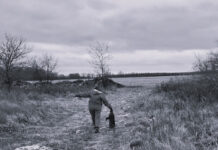Honeybee swarms are nature’s way for bees to propagate or reproduce the species. Swarms typically happen in spring, but they can occur throughout the summer season when conditions in the hive warrant. Seeing a hive swarm is a hypnotizing and exciting sight, as thousands of bees pour out of the hive and hover in the air. They climb higher and higher and slowly shift in the air, as if a breeze is pushing them in one direction or the other. As you watch with amazement, the buzzing noise increases, and you can only hope your swarm will land close by on a low tree branch or bush so you can retrieve them effortlessly and not climb a tree.
Many swarms will land close by in a tree to assemble before they start their journey to a new location. Swarms may land and stay for a few minutes, an hour or even a day, then take off just as suddenly, unpredictably disappearing from sight.
It’s a sad feeling seeing a swarm from your hive fly tree top high, knowing that you just lost half of a productive hive. “One man’s loss is another man’s treasure” surely comes to mind, and you hope that maybe one of the swarm boxes that you set out will be in range to attract them. Many times, they may find an unoccupied hive in your apiary and set up shop.
There are a great many variables in beekeeping, but trust me, dear reader, if you have bees, no matter how closely you manage your hives, your hives will eventually produce a swarm.
Who owns a swarm?
There are many management practices that can lessen or mitigate swarming in your bee yard, but eventually, you will produce a swarm.
When your neighbor’s bees take off and land in your yard or swarm box, are they legally yours? Do you know if they actually came from your neighbor’s hives? Even if they did, they’re still presumed to be free-range bees.
The U.S. Department of Agriculture classifies bees as livestock, but unlike open-grazing cattle in the 1800s, they do not carry a registered brand to determine ownership.
Some beekeepers do mark their queens with a spot of paint on their thorax, which is located just behind the head. However, color coding is mainly used to help locate the queen within the hive and determine the age of the queen.
For queens reared in 2025, the color is blue; 2024 was green, and in 2026 the color will be white. Other colors used are yellow in years ending in two and seven, and red in years ending in three and eight. This is a universal code that most commercial beekeepers use, but you can use any color you like to help identify and locate your queens.
The Posci art pens you can buy at art supply stores come in a wide variety of colors and are safe to use on queens.
It’s been recorded that some queens have lived as long as 10 years. My buddy Mike had a breeder queen he grafted from for five years before he lost it in a swarm.
Unless the beekeeper was in his apiary and was actively trying to catch his swarm, my opinion — shared by most beekeepers — would be the old finder’s keeper’s natural law. If they landed on your property or in your swarm box, my opinion is they’re yours.
Understanding how swarms relocate
Tom D. Seeley, professor at Cornell University, authored the definitive book on bee swarming, “Honeybee Democracy.” His book explores, through years of research, how swarms collectively make decisions on where and when to relocate. Seeley’s experiments proved that swarms can relocate up to three miles away from their original home. Many other fascinating findings showed swarming bees favored a new home with a southern exposure or entrance.
Seeley caught more than 60 swarms set up in more than 100 sites in his study in 1976. His guidelines, first published in the magazine “Gleanings and Bee Culture” and as a Cornell Cooperative Extension bulletin, stated that a good location is about 15 feet off the ground, highly visible but fully shaded and facing south. This study showed that swarm traps with an attractive scent applied, such as lemongrass oil, will improve the trap’s success as much as five times as ones that don’t use scent.
Seeley’s other significant findings were the size of the nest or cavity the bees preferred. His studies showed bees favored using a bee box of about 40 to 50 cubic liters, which is roughly the equivalent of your standard 10-frame hive. The school of thought is that a smaller-sized cavity or fewer boxes are not as attractive to the swarm because there won’t be sufficient room for honey storage and brood production for bees to survive the winter. Bees typically store and consume up to 40 pounds of honey to make it through the winter.
Swarm traps
My advice about swarm traps is to place your traps in easily-accessible places, like on tree lines or fence posts, and place them no higher than your height or a short step ladder. The main reasons are that I believe higher locations will not substantially increase your success, and the added benefits of increased safety for yourself. Negotiating a box up and down a ladder with a full box of bees can be challenging, with a little risk involved. A successful trap, loaded with a huge swarm, is hard to maneuver up a 10-foot ladder, especially with no help available.
You must take down the loaded trap after you smoke them inside and tape the entrance. Seal the entrance in the early morning or late evening with heavy tape when all the foragers are back in.
When you bring your trap back to your apiary, place it in the exact spot you’re going to transfer them into your empty hive. You can open the swarm box and wait when the bees are out to transfer it into their new home and they will find your new hive entrance by smell.
After you transfer the swarm, you might want to place the swarm box back at the same location because I’ve caught multiple swarms in the same location in one season. I even caught a second swarm as fast as two days later.
Get your boxes up now, as prime time for swarming in northeast Ohio is now through June, and check them every three to four days.
You should see scout bees going in and out of the boxes, and sometimes see a lot of activity. This is a sure sign that they’re checking it out, and you may get a swarm in the next few days or week.
Do not overspray your lure or lemongrass oil. This will act as a repellent and may attract a swarm to land and cluster close by or underneath the side of your swarmbox.
Add the lure near the entrance hole and apply a small amount near a branch near the tree.
Relure the box after a week or after prolonged or heavy rain. The rewards of running your bee trap line, other than FREE BEES, are to get out and experience and enjoy the great outdoors as you become more aware of the flowering trees, shrubs and weeds that support our important pollinators.













